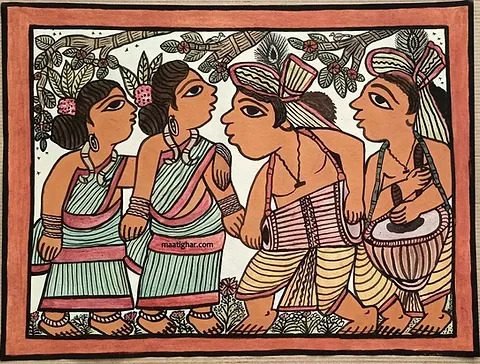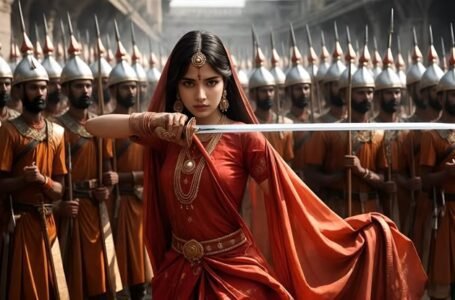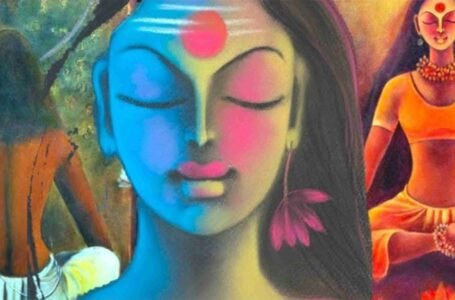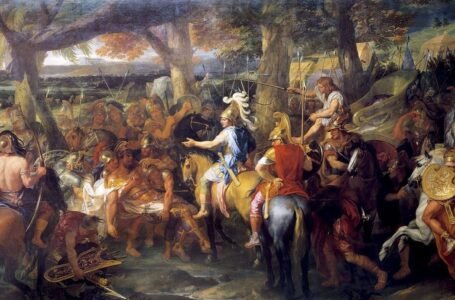Paitkar Painting: A Unique Expression of Life, Death, and Spirituality in Jharkhand

Paitkar painting is a fascinating and ancient art form that comes from the tribal regions of Jharkhand. It’s a beautiful reflection of indigenous culture and spirituality, deeply connected to the traditions of tribes like the Santhal, Munda, and Ho. What makes this art so special is how it vividly portrays themes of life, death, and the afterlife, going beyond just being visually stunning to offer a deeper, spiritual, and philosophical experience. Through its rich blend of mythology, folklore, and existential questions, Paitkar painting stands out as a truly unique cultural treasure that deserves much more recognition and appreciation.
The story of Paitkar painting is closely tied to the history and traditions of the tribal communities in eastern India, especially in Jharkhand, West Bengal, and Odisha. It’s considered one of the oldest tribal art forms in India, believed to date back to prehistoric times, even predating many classical art forms. The name “Paitkar” comes from the local word “Pata,” which means scroll, highlighting the traditional medium used by the artists.
In the past, Paitkar paintings played an important role in tribal rituals and ceremonies. Tribal priests and shamans, known as “Deori” or “Ojha,” used these scrolls as visual aids to narrate myths, legends, and moral stories. This rich tradition was passed down orally, ensuring that the skills and knowledge of Paitkar painting stayed alive within the community. However, with the rise of modernization and changing socio-economic conditions, this ancient art form now struggles to survive, facing challenges of preservation and recognition in today’s world.
Paitkar paintings are traditionally created on scrolls made from handmade paper or cloth, with every part of the process deeply connected to nature. The materials used are sourced locally, and the pigments come from natural elements like stones, leaves, flowers, and minerals. For example:
- Red is made from geru (red soil).
- Yellow comes from turmeric.
- Black is created using soot or burnt wood.
- Green is extracted from various leaves and plants.
The brushes are crafted from squirrel or goat hair, allowing the artists to add intricate details to their work. To ensure the scrolls are durable and smooth, they’re treated with a paste made from tamarind seeds mixed with water. Every step reflects a harmonious relationship with the environment, keeping the art form authentic and rooted in tradition.
The scrolls of Paitkar painting are uniquely designed in a horizontal format, which makes them perfect for telling stories in sequence—almost like an ancient version of a comic strip or storyboard. What sets these paintings apart is their intricate detailing, earthy tones, and beautifully symmetrical patterns, all of which reflect the artists’ deep bond with the natural world around them.
Paitkar paintings delve into deeply philosophical themes that are rooted in the tribal way of life. They tackle universal questions about existence, mortality, and the spiritual journey of the soul. These ideas are often brought to life through mythological stories and symbolic imagery, weaving together a rich and meaningful expression of culture and spirituality.
Paitkar paintings portray life as a beautiful harmony between humans, nature, and the divine. They often feature scenes from everyday life—farming, hunting, or community celebrations—that highlight the deep connection tribal people share with their environment. A recurring theme is the cyclical nature of life, symbolized through the sun, moon, and other elements of nature.
A particularly popular subject in these paintings is creation myths, which explore the origins of life and the universe. These stories often depict deities and natural forces working together to bring life into existence, emphasizing the interconnectedness of all living things.
In the Paitkar tradition, death isn’t viewed as an end but rather as a transition to another realm of existence. The paintings often depict the soul’s journey after death, guided by ancestors or spiritual beings. This theme is deeply connected to the rituals and beliefs surrounding death in tribal communities.
One of the most striking elements in these artworks is the depiction of “Chitrakut,” a river that separates the world of the living from the world of the dead. The soul is often shown crossing this river with the help of divine beings or ancestors. This powerful imagery represents not an end, but a sense of continuity and transformation.
Spirituality in Paitkar painting is deeply rooted in tribal mythology and shamanistic traditions. These paintings act as a bridge between humans and the divine, often featuring gods, goddesses, and supernatural beings. They’re also used in rituals to invoke blessings, protect against evil spirits, and ensure the community’s well-being.
One of the central spiritual themes is “Mukti,” or liberation. Many paintings illustrate the soul’s journey toward liberation, guided by spiritual mentors or deities. This reflects the tribal belief in the cyclical nature of life and the ultimate goal of uniting with the divine.
Paitkar paintings are full of symbolism, with each element carrying its own deep meaning. Here are some of the most common symbols and what they represent:
- The Tree of Life: This symbolizes the interconnectedness of all life forms and the cyclical nature of existence.
- The River: It represents the flow of life and the soul’s journey.
- Animals: Often shown as protectors or spiritual guides.
- Masks and Faces: These reflect the duality of life and the presence of the divine in everyday life.
The use of vibrant colors also carries symbolic weight. For example, red is often associated with energy and vitality, while black represents mystery and the unknown. Each color and symbol adds another layer of meaning, making the artwork even more profound.
Paitkar paintings are full of symbolism, with each element carrying its own deep meaning. Here are some of the most common symbols and what they represent:
- The Tree of Life: This symbolizes the interconnectedness of all life forms and the cyclical nature of existence.
- The River: It represents the flow of life and the soul’s journey.
- Animals: Often shown as protectors or spiritual guides.
- Masks and Faces: These reflect the duality of life and the presence of the divine in everyday life.
The use of vibrant colors also carries symbolic weight. For example, red is often associated with energy and vitality, while black represents mystery and the unknown. Each color and symbol adds another layer of meaning, making the artwork even more profound.
Paitkar painting is much more than just an art form; it’s a repository of tribal knowledge, beliefs, and values. It serves as a way to preserve and pass down cultural heritage, ensuring that the wisdom of the ancestors is kept alive for future generations. These paintings also reflect the tribal community’s profound respect for nature and the harmonious way of life they strive to maintain.
Despite its deep cultural and spiritual importance, Paitkar painting faces several challenges today. The rise of industrialization, urbanization, and globalization has led to a decline in traditional art forms, as younger generations increasingly gravitate toward more financially rewarding career paths. The lack of recognition and support from mainstream art institutions has only made things harder.
However, there have been positive efforts in recent years to revive and promote Paitkar painting. Government initiatives, NGO programs, and individual artists have all played a key role in bringing this art form to a broader audience. Through workshops, exhibitions, and collaborations with contemporary art projects, awareness and appreciation for Paitkar painting have grown.
One significant initiative has been the creation of art cooperatives and training centers in tribal villages, encouraging young artists to learn and continue the craft. Additionally, the rise of digital platforms and social media has opened up new ways for artists to showcase and sell their work, providing much-needed economic support.
Paitkar painting is a powerful reflection of the human experience, delving into themes of life, death, and spirituality through the lens of tribal culture and mythology. Its intricate detail, vibrant symbolism, and deep philosophical meaning make it a truly unique and invaluable part of Jharkhand’s cultural heritage.
As we work to preserve and promote traditional art forms in today’s rapidly changing world, it’s crucial to recognize and support the artists and communities that keep these traditions alive. By celebrating and valuing Paitkar painting, we not only honor the rich cultural legacy of Jharkhand but also gain a deeper understanding of the universal truths that bind us all.


